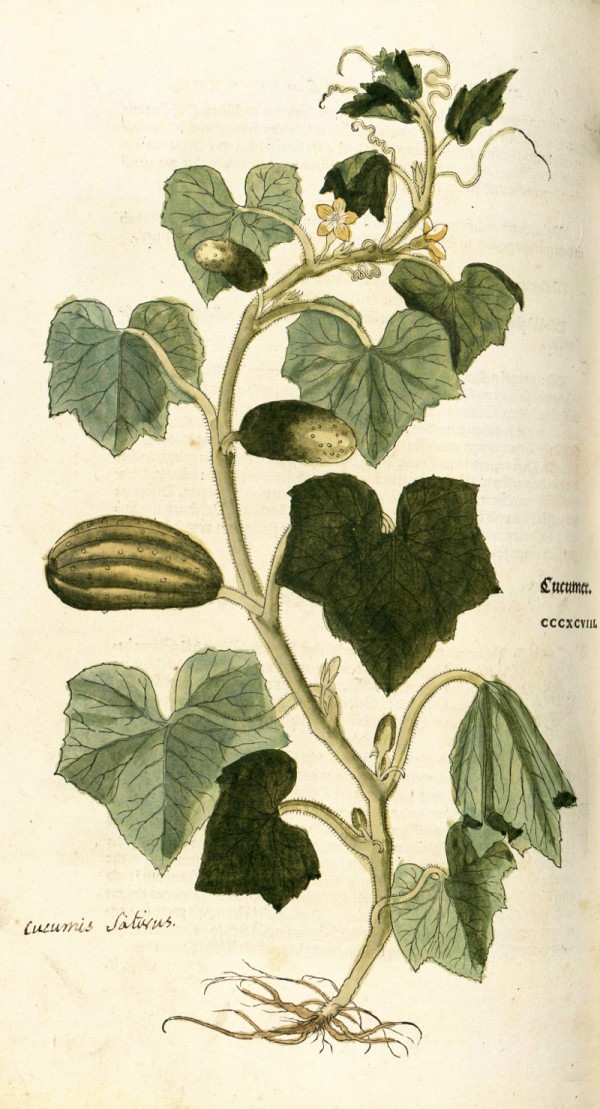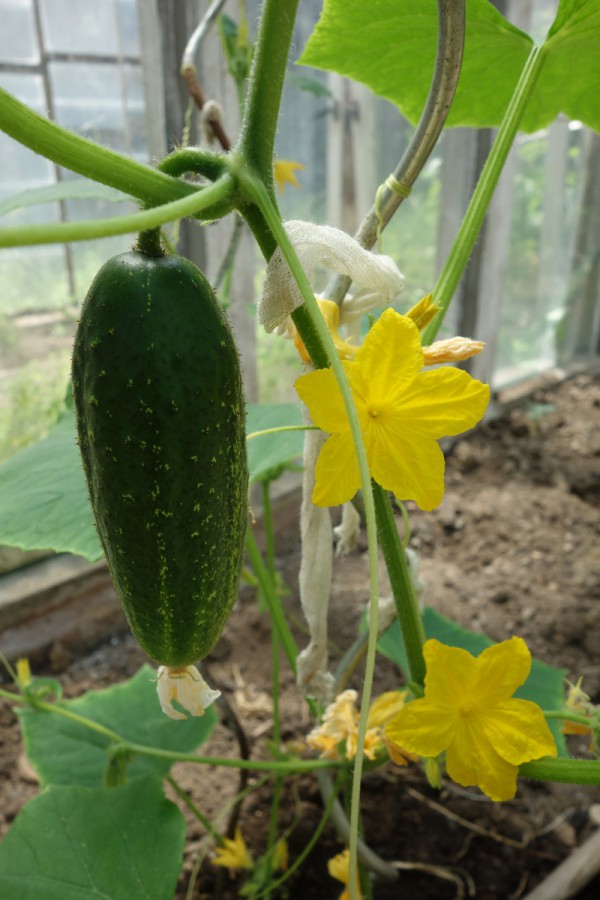Cucumis sativus L. - Cucurbitaceae - cucumber, Gurke
Annual creeping vine, native to India and Southeast Asia, commonly cultivated in tropical and temperate regions; leaves broadly ovate-cordate; male flowers campanulate, white-yellow, densely white pubescent; female flowers solitary, pedicels pubescent, ovary fusiform; fruit cylindric or oblong, up to 50cm long, usually verrucose.
http://www.efloras.org/florataxon.aspx?flora_id=2&taxon_id=200022616
„Traditional cultivars produce male blossoms first, then female, in about equivalent numbers. Newer gynoecious hybrid cultivars produce almost all female blossoms. They may have a pollenizer cultivar interplanted, and the number of beehives per unit area is increased, but temperature changes induce male flowers even on these plants, which may be sufficient for pollination to occur.“
http://en.wikipedia.org/wiki/Cucumber
„The volatile components of cucumbers and muskmelons were analyzed by a technique which reveals the odorants having the highest odor units (ratio of the concentration to the odor threshold). (E/Z)-2,6-Nonadienal, followed by (Z)-2-nonenal and (E)-2-nonenal were the most significant odorants of cucumbers.“
[Evaluation of potent odorants in cucumbers (Cucumis sativus) and muskmelons (Cucumis melo) by aroma extract dilution analysis., Schieberle, P., Ofner, S., Grosch, W,, Journal of Food Science, Vol.55(1), 1990, 93-195]
„The volatile (E,Z)-2,6-nonadienal (NDE) gives cucumber its 'fresh green' flavor and confers resistance to some bacteria and fungi. Lipoxygenase and one type of hydroperoxide lyase, 9-HPL, synthesize NDE from linolenic acid precursors. Genes encoding enzymes with 9-HPL activity are rarely found in other plants. However, cucumber contains two tandem HPL genes, one of which has been experimentally confirmed as encoding an enzyme with 9-HPL activity. The expansion of the LOX gene family and the duplicated HPL genes may be related to the high level of NDE synthesis in cucumber.“
[The genome of the cucumber, Cucumis sativus L., Huang, S., Li, R., Zhang, Z., Li, L., Gu, X., Fan, W., Miao, H., Nature genetics, Vol.41(12), 2009, 1275-1281]
http://www.nature.com/ng/journal/v41/n12/suppinfo/ng.475_S1.html
„The volatiles of three Greek cucumber cultivars (Cucumis sativus L.) were analyzed by gas chromatography and mass spectrometric detection. Twenty-one components were identified. The major components from each sample were found to be: sample A, Z-6-nonenol (61.54%), E-2-nonenal (6.98%), sample B, E,Z-2,6-nonadienal (47.08%), E-2-nonenal (17.39%), Z-3-nonenol (14.79%), 3-nonenal (7.32%), sample C, pentadecanal (43.47%), 9,12,15-octadecatrienal (14.52%) and 9,17-octadecadienal (12.33%). Additionally, several constituents have been isolated and identified from the dichloromethane, and methanolic extract of fruits from sample B. It was found that cucumber contained a high concentration of L-(+) lactic acid which, as a member of α-hydroxy acids (AHAs) with established use in cosmetology, could explain the traditional use of cucumber in skin treatment.“
[Chemical analysis, antioxidant and antimicrobial activity of three Greek cucumber (Cucumis sativus) cultivars., Sotiroudis, G., Melliou, E., Sotiroudis, T.G., Chinou, I., Journal of Food Biochemistry, Vol.34(s1), 2010, 61-78]
„The odoriferous principle of freshly cut cucumbers is a mixture of (2E,6Z)-nona-2,6-dien-1-ol and (2E,6Z)-nona-2,6-dienal, and both compounds have also been found in a number of vegetables such as Spanish pepper, as well as in potato chips and other fat-containing products including various meats.“
[Scent and Chemistry, Günther Ohloff, Wilhelm Pickenhagen, Philip Kraft, Wiley-VCH, 2012, 279]
„… 13 aroma impact compounds were identified: (E,Z)-2,6-nonadienal, (E)-2-nonenal, hexanal, (E)-2-hexenal,
(E)-6-nonenal, nonanal, (Z)-2-heptenal, pentanal, propanal, (E,E)-2,4-heptadienal, 1-nonanol,
1-nexanol, and (Z)-3,6-nonadien-1-ol… The (E)-2-nonenal / (E,Z)-2, 6-nonadienal ratio also decreased with fruit development, which was accompanied by an increase in ‘cucumber-like’ flavor.“
[Chen, Shuxia, et al. „Profiling of volatile compounds and associated gene expression and enzyme activity during fruit development in two cucumber cultivars.“ PloS one 10.3 (2015): e0119444.]
fermented cucumber (pickle)
„The present study compares volatiles and semivolatiles in a typical fermented cucumber brine sample… The seven odorants with the largest SNIF values were (from highest to lowest) trans-4-hexenoic acid with a peak number of 36, cis-4-hexenoic acid at peak 37, 2-heptanol at peak 43, cis-2,4-hexadienoic acid at peak 47
(a tentative identification), phenyl ethyl alcohol at peak 35, 2,6-nonadienal at peak 48, and 2-dodecen-1-al at peak 49 (also a tentative identification). Based on SNIF values, trans-4-hexenoic acid was by far the
most powerful odorant observed in the brine sample. The trans-4-hexenoic acid and cis-4-hexenoic acid were detected by all panelists and were the only odorants characterized as definitely similar to the aroma of the brine sample. One other odorant that was observed in many samples of brine but not in the one studied here was phenyl acetaldehyde.“
[Marsili, R. T., and N. Miller. „Determination of Major Aroma Impact Compounds in Fermented Cucumbers by Solid-Phase Microextraction—Gas Chromatography—Mass Spectrometry—Olfactometry Detection.“ Journal of chromatographic science 38.7 (2000): 307-314]
Cucurbitacin C as strongly bitter component of C.sativus shows a threshold value of less than 0.1ppm.
[Cucurbitacin C - Bitter Principle in Cucumber Plants., Horie, H., Ito, H., Ippoushi, K., Azuma, K., Sakata, Y., Igarashi, I., Japan Agricultural Research Quarterly: JARQ, Vol.41(1), 2007, 65-68]
Nonbitter cultivated cucumber fruit own a 'bt' allele selected during domestication. „With genomics and biochemistry, we identified nine cucumber genes in the pathway for biosynthesis of cucurbitacin C and elucidated four catalytic steps. We discovered transcription factors Bl (Bitter leaf) and Bt (Bitter fruit) that regulate this pathway in leaves and fruits, respectively. Traces in genomic signatures indicated that selection imposed on Bt during domestication led to derivation of nonbitter cucurbits from their bitter ancestors.“
[Biosynthesis, regulation, and domestication of bitterness in cucumber., Shang, Y., Ma, Y., Zhou, Y., Zhang, H., Duan, L., Chen, H., Huang, S., science, Vol.346(6213), 2014, 1084-1088]

Fuchs, L., New Kreüterbuch, t. 398 (1543)
http://plantgenera.org/species.php?id_species=297394

Fruiting cucumber, CC BY-SA 3.0, Author: Andreas Kraska
